
Episode Sixteen…
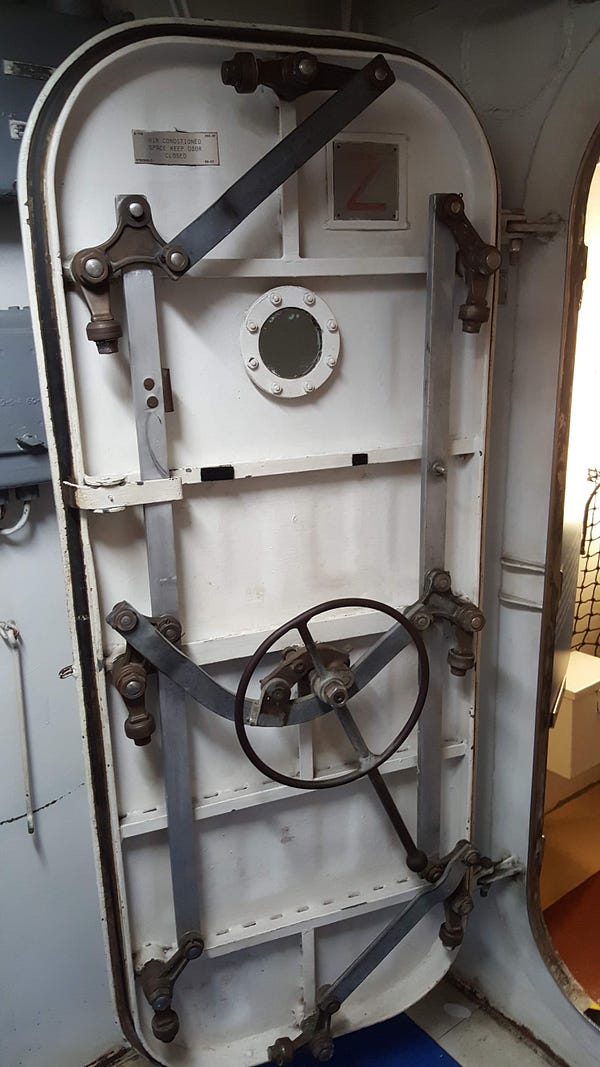 |
| Books by B J Thompson |
When you see a ship’s hatch, it’s rather startling… or it is to anyone who knows that such a device can allow for egress and can seal a tomb. Once those levers are “dogged,” there’s no escape. It’s difficult to stand by this doorway and not feel nervous, not breathe in a little deeper.
 |
| Books by B J Thompson |
The “coffin racks” as these beds have been called. The mattresses are very thin and although I did not attempt to lie down, I could tell it was pretty much a given I’d bump body parts on the way in. I’m assuming that to be claustrophobic and a sailor rarely mixes.
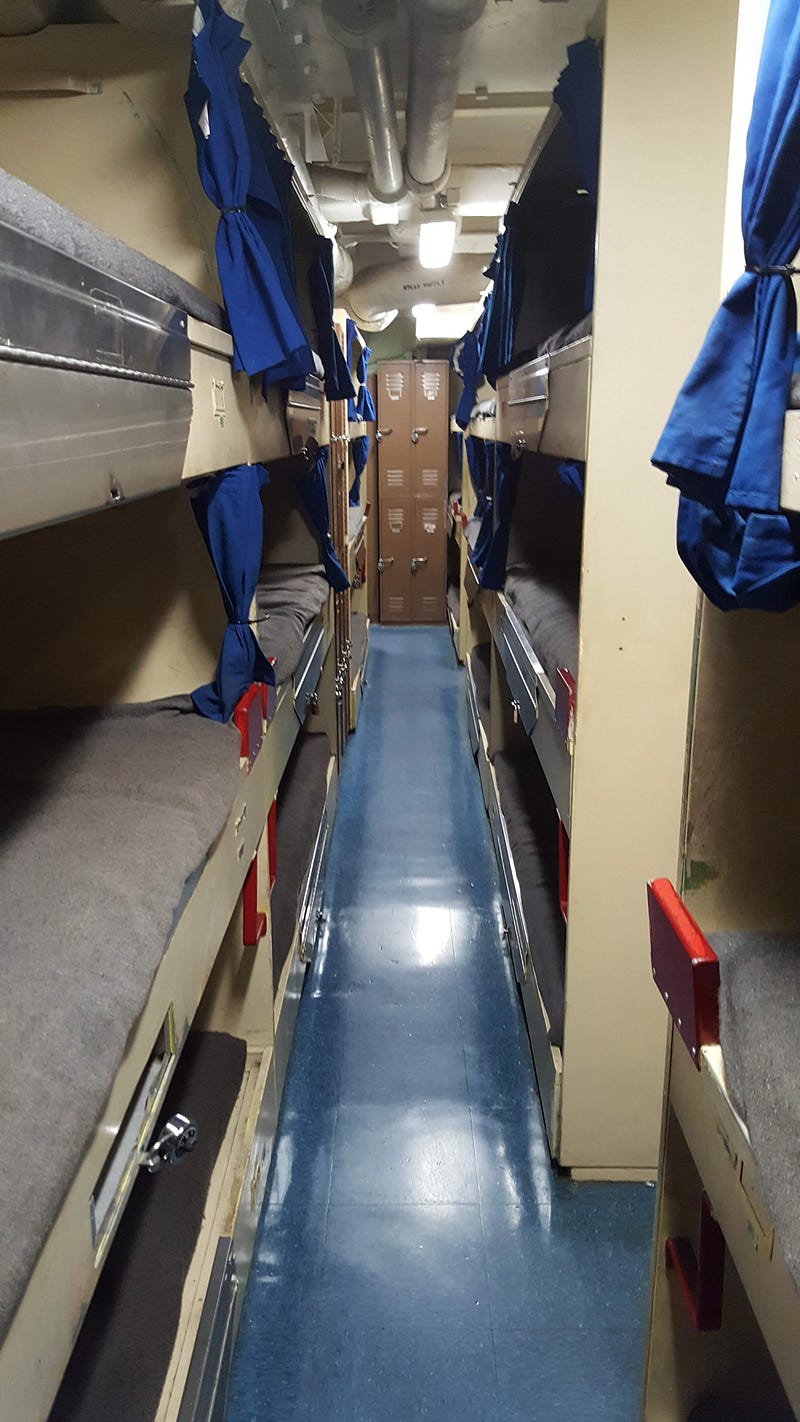 |
| Books by B J Thompson |
And by this hall photo, you better be dead thin, too. If you didn’t know your fellow sailors on the day you came aboard, one night in crew quarters and you had better be best friends. Days, weeks, months at sea…how tempers must have flared.
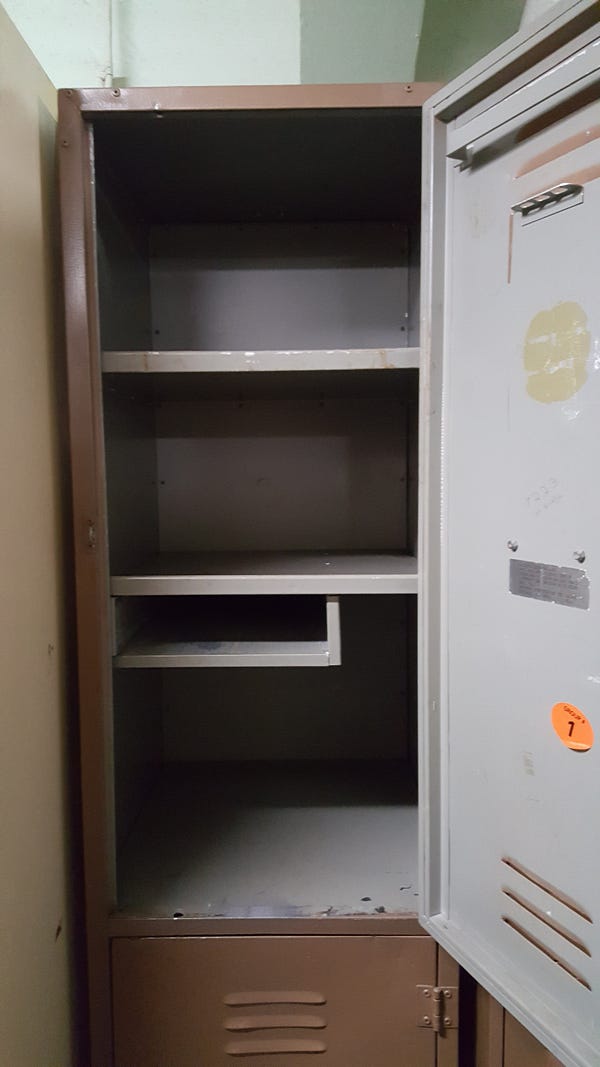 |
| Books by B J Thompson |
The standard crew locker. All your worldly goods must fit inside this tiny compartment. The message you get onboard is a battle ship is a team. The individual is not present. Engines and armaments and man power fuse to create a singular floating weapon. I have no idea where you’d stow your personality at this point.
The Truman Line. Your chow HQ. Grab a tray and move along, and I’m thinking you have to like "shit on a shingle", aka beans on toast.
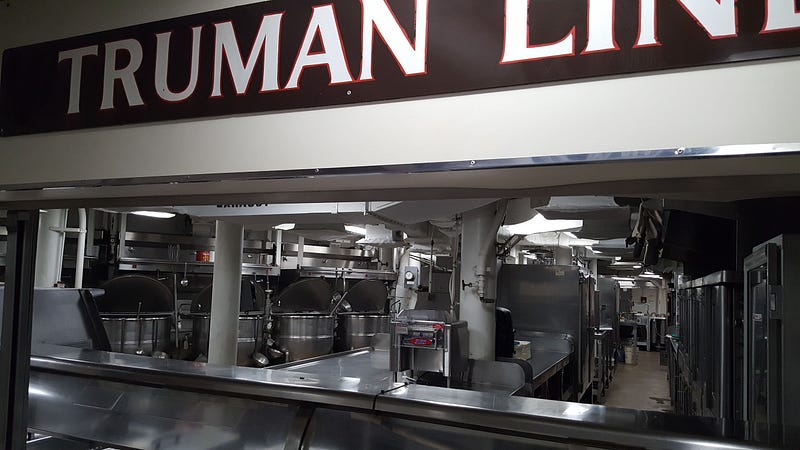 |
| Books by B J Thompson |
The Mighty Mo’s post office. From here, all hopes and dreams and love letters enter and exit. The human lifeline necessary to keep morale afloat. When I peered into this tiny room, I thought of boys who maybe had no one back home. If I had worked in this P.O., I would have written to those boys. Every sailor deserves mail.
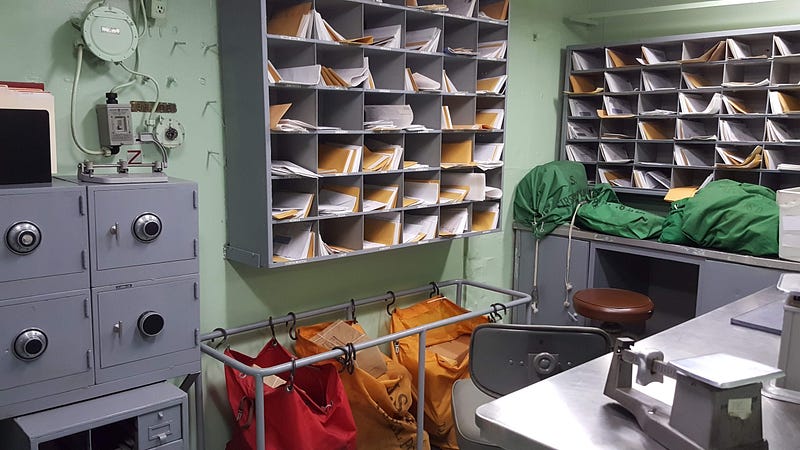 |
| Books by B J Thompson |
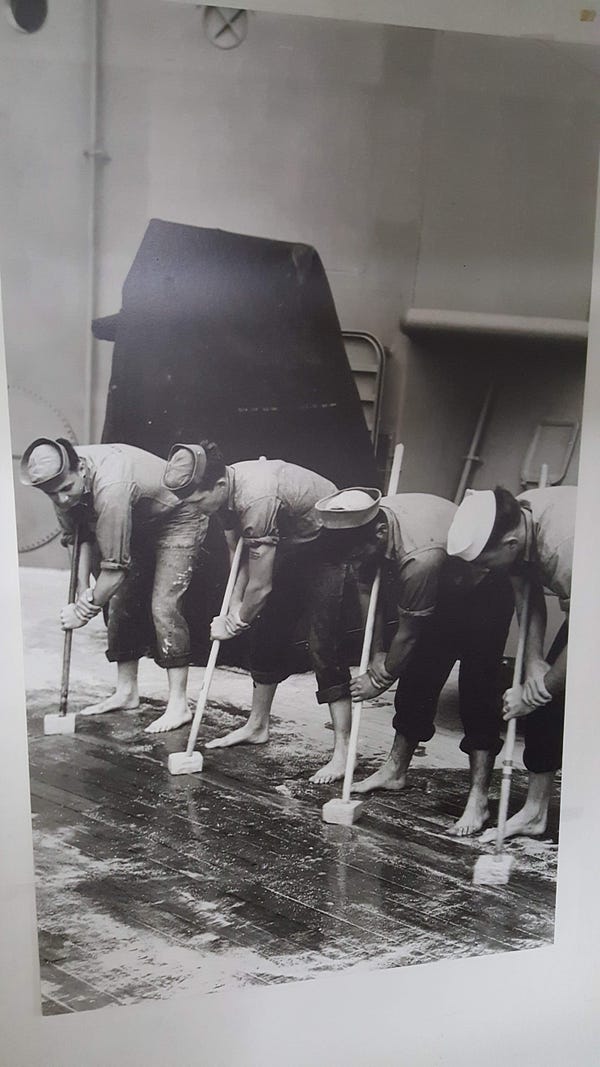
Photo of a scrubber/swabbing detail. A broomstick and a brick called a “Holystone” were the tools. And along with sea water and sand, you scrubbed with the grain the Main Deck teak boarding until a white pristine, having the feel and sheen of satin. I can attest. I knelt down to feel the boards on the Missouri, and you indeed with petting satin. If you came aboard as a scrawny ensign, I doubt you were leaving as one with this job.
Two ID cards sat under glass in the artifacts area of the Missouri. The one was your personal ID that proved you served aboard ship.
 |
| Books by B J Thompson |
The other was a Surrender Card, confirming a sailor’s presence aboard the USS Missouri, proof that he had witnessed the formal surrender of Japan to the Allied Forces in Tokyo Bay, September 2, 1945.
 |
| Books by B J Thompson |
I cannot imagine what those 23 minutes must have felt like, but in me, when I saw this card, all emotions roiled to the surface — of sorrow and rage and bloody relief, of mourning sailors who should have been present but were long since dead below the sea. To view this card is to view the end of death… but at what price? MacArthur, Nimitz and Halsey and Murray… what were their feelings as they signed these cards?
Episode Seventeen…
I think I see ghosts everywhere on this ship. Okay, not ghosts exactly, but images, like a tape rewind of what I think occurred on any battleship during the war. To me, I see the Captain and the Exec and a couple of officers playing cards at this table, but it’s not the game that’s intriguing, it’s what they’re saying to one another. Sure, the day is done and the orders are given, and maybe the brass belts are cinched out a wee bit after dinner, but these men, they have concerns, and maybe they voice those concerns around a game of cards. How much did the captains even know what hit as Washington telegrams coming into CINCPAC — Pearl Harbor HQ? “Loose lips sink ships,” right? But captains don’t become captains without a strong instinctive gut. This card table worried me when I saw it. I didn’t hover long…
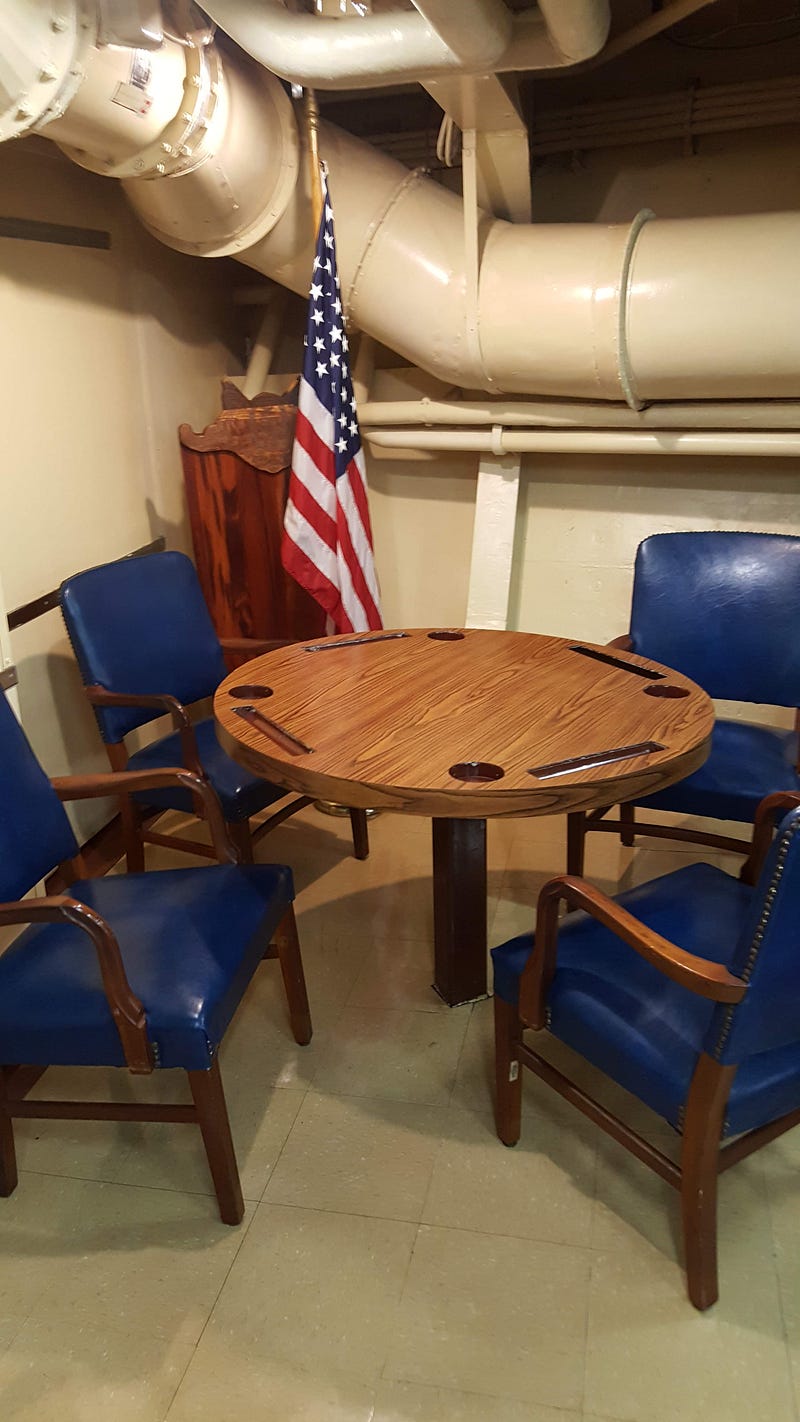 |
| Books by B J Thompson |
I took a photo of one of the ladders heading up to Main Deck and freedom.
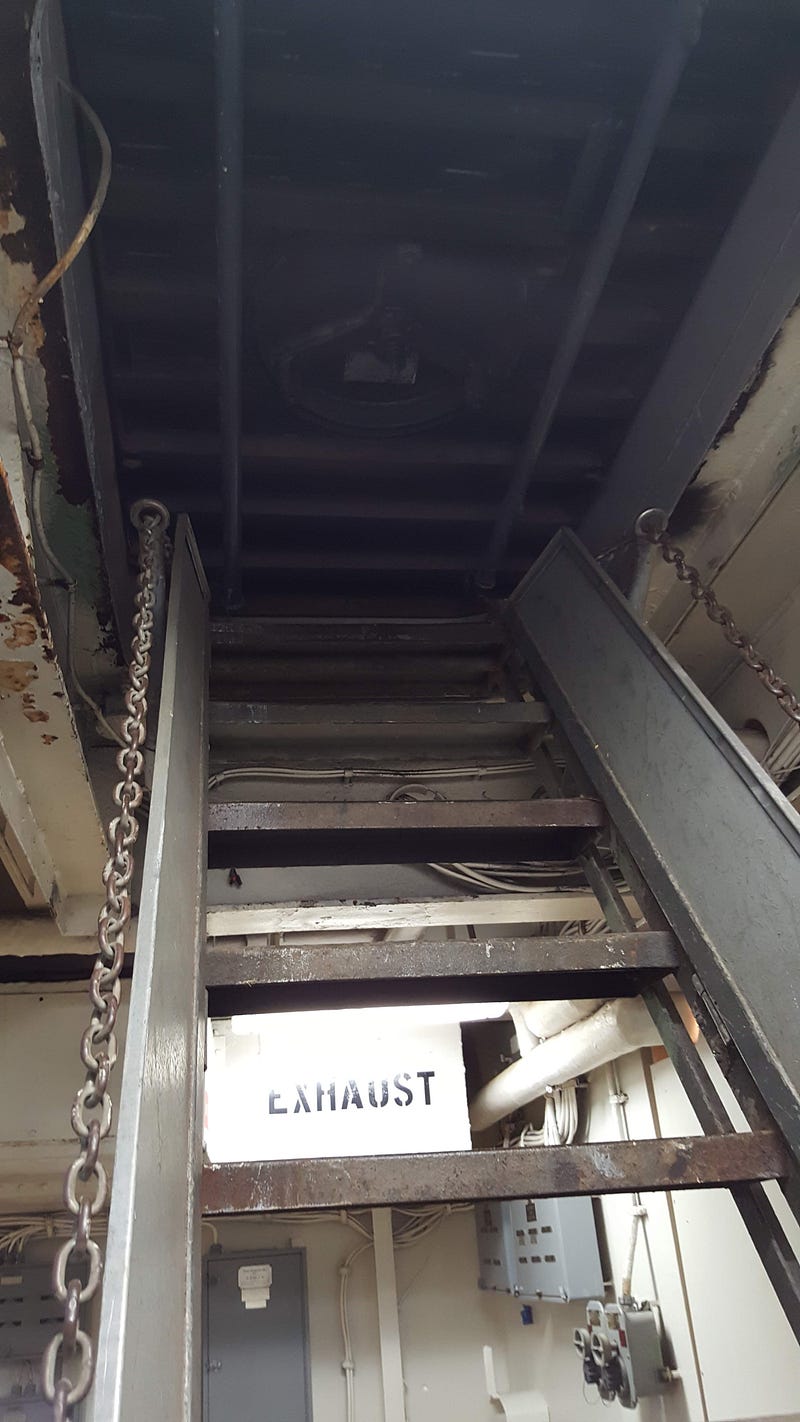 |
| Books by B J Thompson |
This is all the room you have and it’s a miracle if as a civilian you don’t bump something on the way up. Take this ladder, turn it upside down and put it in the dark with HUNDREDS of sailors trying to escape. I looked up at this ladder and I felt fear. Maybe you have to enlist. Maybe it’s a calling to be a warrior like it is for a doctor or a nun or anything else. I’m not sure at 20 something I would have the mental fortitude even though I had the strength. Not at mid-fifties, I don’t have the same strength and I’m still not sure I have the mental fortitude. Look at this photo and remember Pearl Harbor, won’t you?
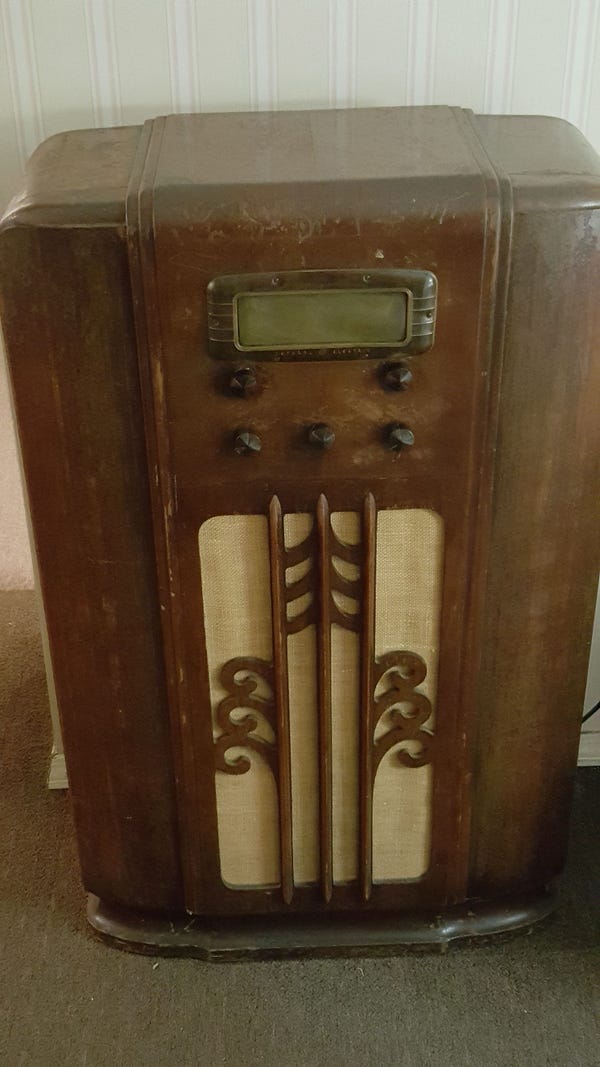 |
| Books by B J Thompson |
A typical radio in ’41. Tubes that had to “warm up” and fiddling with the dial to get in a station clearly. In Pearl, it would have been KGMB, and on the Saturday night, all music, all the time as a dozen or so B17s were expected in from the mainland that Halsey would have shipped on the USS Saratoga carrier to the Far East. Radios like this were “portable” if by portable you meant using biceps you though you never had. That Saturday night, December 6th, peaceful Hawaii music or Big Band tunes. All sounded fine as paradise is…right until it melts into war. Radios like this would have went down with the wounded battleships and most likely junked after recovery. Even objects died at Pearl Harbor.
In a display case:
- matches made after the attack — “REMEMBER PEARL HARBOR” — the saying that was echoed by all in North America. Remember what happened and make damn sure it doesn’t happen again, was the feeling.
- a sailor’s Liberty Pass card needed to go ashore on the night of December 6th, 1941
- and what I assume was a Junior Officer’s coffee mug as the enlisted ones had no handles and the ones in Officer Country were bone china. This one was found under where the Missouri floats today, so evidently this mug came from the Oklahoma or the Maryland, held by a sailor long since gone. I look at these pieces of time and feel sadness but I think that’s wrong. They were held by content sailors prior to the awful Sunday morning, but there’s a heaviness at Pearl now that drowns out the better times. I wonder if that’s fair.
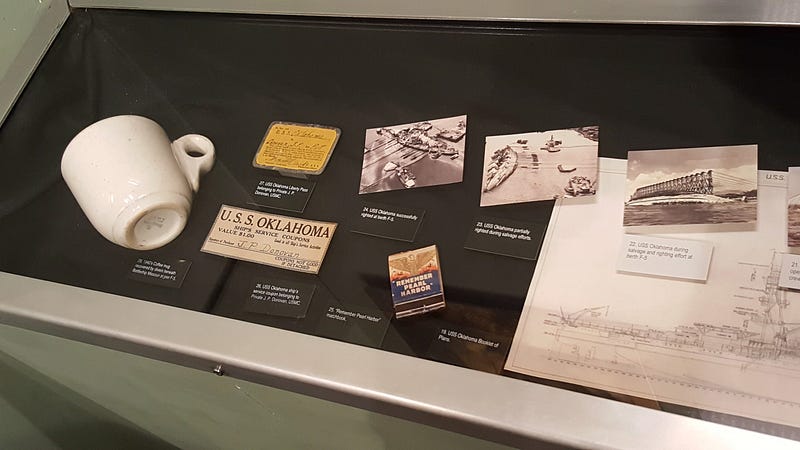 |
| Books by B J Thompson |
- A pack of Lucky Strike cigarettes and a metal Zippo lighter. Those lighters made a nice sound when the men would open them up. A kind of “flick” and a grinding on the flint before the flame appeared. On the rarest of occasions when I hear one, my mind zooms back to my father, and I smile. I’m not sure what was so “lucky” about Lucky Strikes. The WWII generation, most ended up with emphysema, but you can’t blame them. Nobody then knew the health effects. But hey, in those war years, if you needed a smoke, bloody have a smoke, is what I say. I’d like to see modern society cope in those years without some kind of crutch.
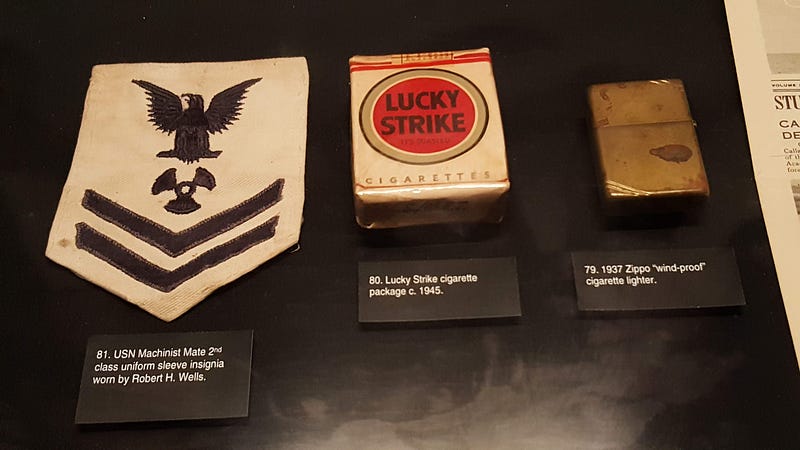 |
| Books by B J Thompson |
Months after these photos were taken, I sit quietly and gaze at them. The experience then even a ghost now, but I sit reverent, silent. The connection is there. Time ticks down, over and over again, at Pearl Harbor — Saturday, Sunday, 0755 — an endless replay there and forever in my mind and with “my boys” in AIR. I as the weaver and they as the fighters, we are cast together as the clock ticks down…
Episode Eighteen…
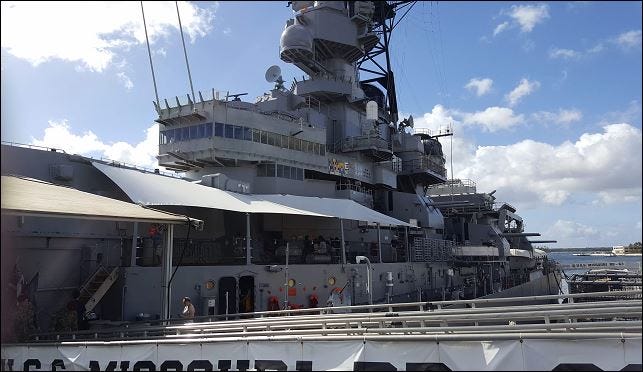 |
| Books by B J Thompson |
Leaving the Missouri was rather difficult. I had this overwhelming feeling I’d never be aboard again. My back hurt and I was tired, but full of everything a writer needs, none of which can be cemented into clear thought for you, just a feeling that one’s experience tank was full as per a glimpse into battleship life. As with any calling, I believe to be a sailor is — the close quarters, the hard steel everywhere, all minimalist, and every square foot with a direct purpose. A condensation of life in peace time; a condensation of death in war. As I walked down the gangway, I knew this world would remain rather alien to me, but I’d had enough to appreciate what my characters would live through. I can say that it takes daily courage to be a sailor, in peace or in war. When my feet hit dry ground, I looked back up at her and was silently relieved. I shall always remain an observer… a well-grateful observer of the freedom-loving seafaring men and women around the globe who do for me, as I cannot.
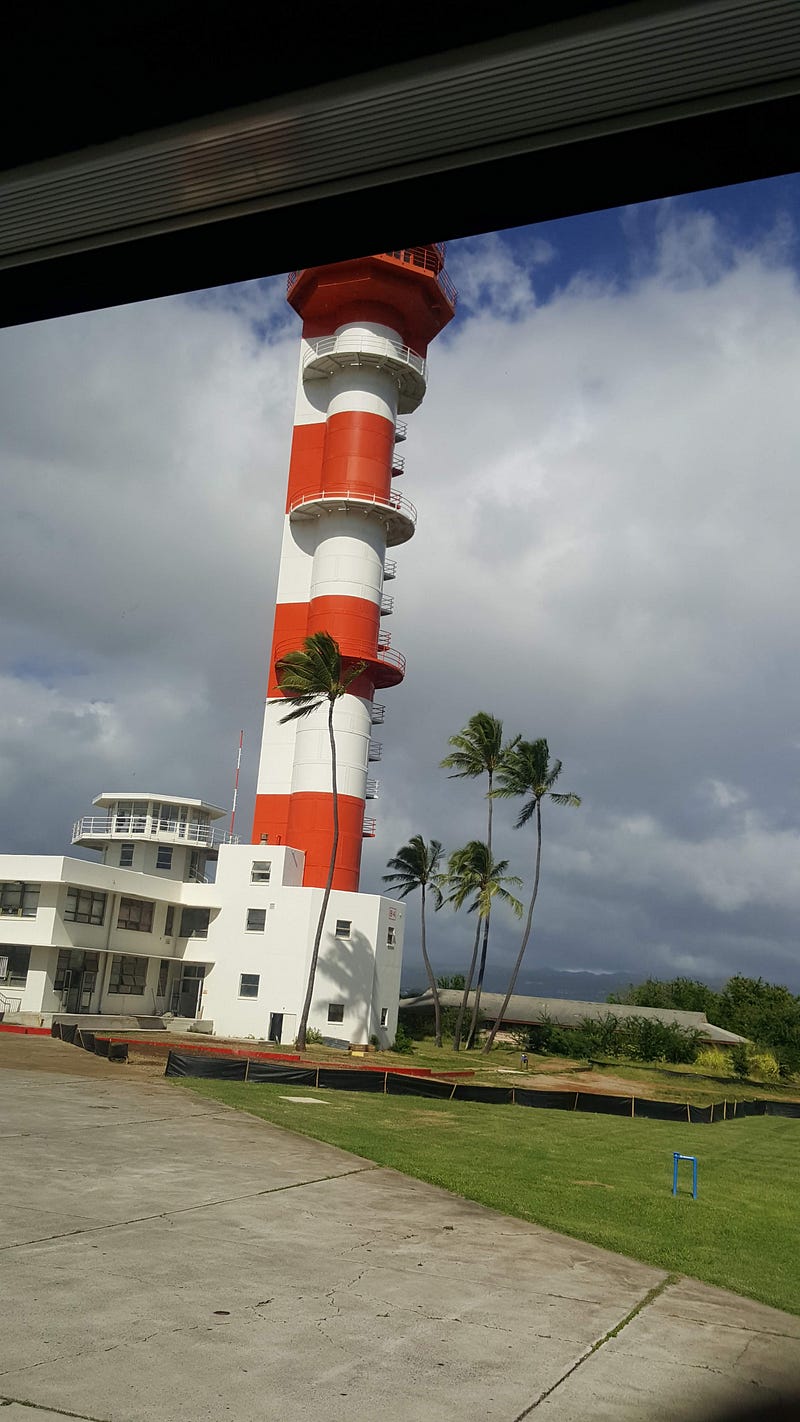 |
| Books by B J Thompson |
The last area I spied on the bus heading off Ford Island was the airstrip and the control tower. The Pearl Harbor Historic Parks are desperately trying to restore the tower before rust has it crumble to the ground, as it sat abandoned for decades. As you can see in this photo, it’s come a long way from the rust bucket it once was. It’s getting a new lease on life, and I’m so glad, for it was always that background photo beacon during the bombings, standing tall amid the destruction and chaos. In so many ways, the tower holds so much meaning for me… that some things WILL remain… that some good eyes WILL outlive the invading evil, and will keep a quiet watch for its return.
The airstrip itself has been allowed to grow back to grass. No asphalt remains, but no obstructions lay on its path either, hinting that if ever again needed, it silently waits.
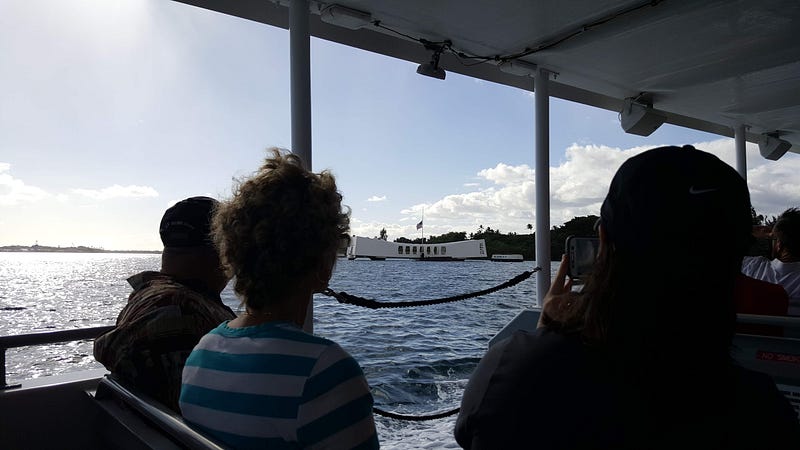 |
| Books by B J Thompson |
My next stop was the motor-launch to the Arizona Memorial. This was simply to pay my respects and to do what my Dad would have wanted to do if he had had the chance. The boat was full and we were not allowed to stand, so my photos are as catch-can. The engine startled me. It’s an inboard and unbelievably powerful. The sailors assigned to work her were above reproach, utterly courteous and professional… and so very young. The age of “my boys,” my characters in AIR. They didn’t take much notice of me, but I did of them. My urge was to hug them as a mother would do. Good thing I can keep my writers lunatic urges at bay.
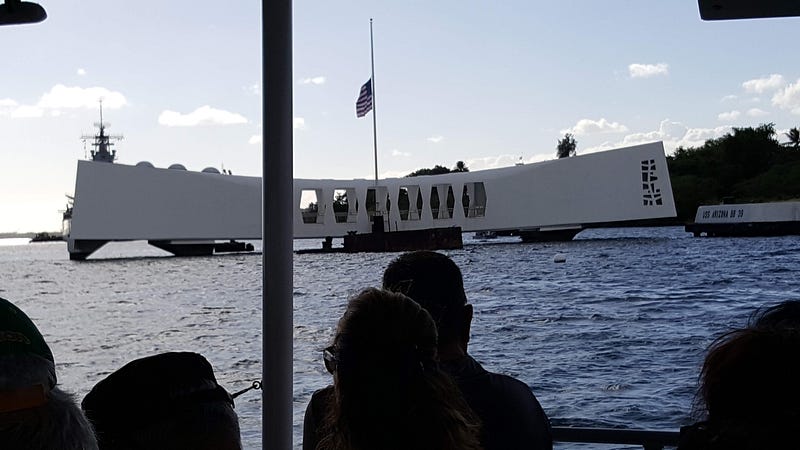 |
| Books by B J Thompson |
The closer you get to the memorial, the harder it is to swallow. Too much death. I could feel it. There’s no sense of lingering torture, but of a wipe out, an instant cut-off of air, of life, replaced by the disintegration of men, and muted death. You FEEL death all around you. I thought it would be a peaceful place but it wasn’t for me. Very heavy. You’re drowning in the dead, not in a haunting way, a suffocating way. The reverberation of the explosion is still there. The body disintegration blood-red mist is still there. War… is still there. We who look on, we don’t break through nor affect the wall. The past e’er plays out as a constant replay. Being a looky-loo, I had mixed feelings. I felt we were disturbing the dead, but I also get the sailors are happy we visit. They tell me they prefer the evenings once the motor-launches quit for the day. They don’t like those engines. They do like the peace and quiet. But oh, how they like our visits!
Closer still to the water. There is no way around it. The water in Pearl Harbor I do not like. It’s holding hard thoughts. The land, the sights all around you, all beautifully kept. Flowers bloom, palm trees sway, warm, fragrant breezes, paradise at every turn…except for the water. It knows better. If you want to “feel” the Pearl Harbor attack from 77 years ago, look into the water. It has a long memory.
 |
| Books by B J Thompson |
The dive team was busy at work repairing the ramp structure. Again, so many decades of rust and decay. I was okay with not boarding the memorial. I sensed the men. I heard their call to me. The forward magazine explosion that instantly killed those 1,177 sailors reverberated in my soul. Landing or not landing on the memorial doesn’t arrest the feeling. The result: sickening, sorrowful and a roiling rage.
I know forgiveness is how mankind evolves, moves forward, but when you’re at Pearl, it takes all you have to swallow the past to move on. As I’ve said before, the Pearl Harbor attack I see as a global attack on peace, not any different to 9/11. If you are a peace-loving citizen of the world, a believer in democracy, a champion for all and not merely for the few, then you look at Pearl Harbor as a personal attack. I do. Extremism, radicalism, blind loyalty… a day won’t go by on this earth that we don’t have to be on guard from all that. It’s not a colour problem. It’s not an ethnic problem. It’s an ignorance problem. A lack of education in people from any walk of life.
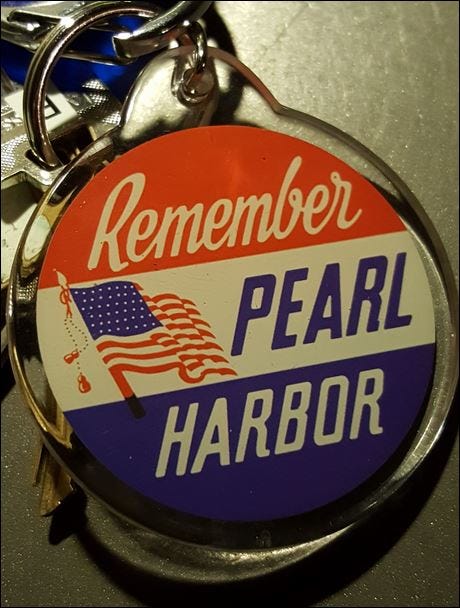 |
| Books by B J Thompson |
As young ones feel the rage from 9/11, older ones feel the rage from December 7th. We walk on, we learn to forgive, but by God, we will NEVER forget.
Episode Nineteen…
There can be MAGIC in war.
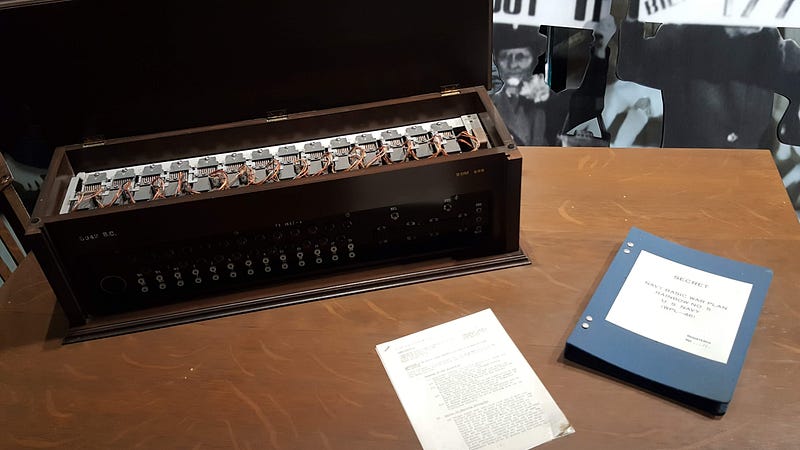 |
| Books by B J Thompson |
MAGIC was the Allied crypto analysis project during World War II, and PURPLE was the machine shown here that broke the Japanese code. Without it the penultimate success at Midway would have never occurred that took the Americans from a defeated navy after Pearl Harbor to top dog and thereafter island hop their way to ultimate victory. This machine is displayed in the Pearl Harbor War Memorial museum.
 |
| Books by B J Thompson |
Japanese Consulate employee, Takeo Yoshikawa, was Japan’s Honolulu/Pearl Harbor spy. He would often dress down like a poor “kanaka kāne,” local Hawaiian, and act like a nobody as he spied Honolulu’s port from River Street or sketched battleship positions at Pearl from the...
 |
| World At War Series — 1970s Photo |
Aiea district above the harbor. It’s tough to look at this young, serene face and know that every man, woman and child who died horrific deaths on December 7, 1941 was directly due to his spy craft. We know his last sketch was made on the Saturday before the attack, evinced by his last sketch placing the battleship USS Oklahoma out board of the Maryland. The Okie only left her position outboard on the Nevada on that final day. Takeo was quietly doing his job to kill us. That is a damn hard pill to swallow, even after all these decades.
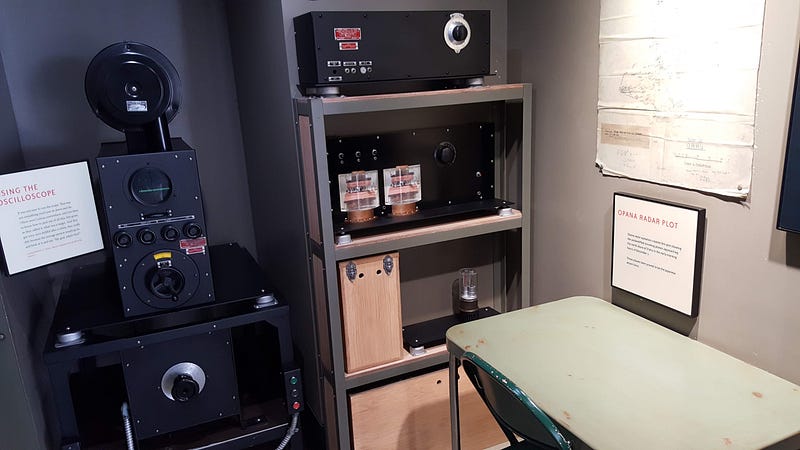 |
| Books by B J Thompson |
This is the oscilloscope type used at Kahuku Point, Oahu’s most northerly outpost. If you stand by the machine for several minutes, you will hear a mock-up conversation between Army Privates, George Elliott and Joseph Lockard, and the Information Center at Fort Shafter, and watch the green line spike to over 2 inches high from a direction 137 miles to the north, a signal that would not equate to the dozen B17 bombers scheduled incoming from San Francisco but rather 183 Japanese bombers and torpedo planes coming in from the carriers Akagi, Kaga, Soryu, Hiryu, Shokaku and Zuikaku. Hindsight is always 20/20 but it’s difficult to believe that spike was taken for a mere dozen planes, but when you’re just learning the ropes and nobody from the top brass down suspected an Hawaiian attack, what should be obvious, sadly isn’t. That black machine, if read right, could have saved thousands of lives on that Sunday. It’s very difficult to look at it and not feel helplessness.
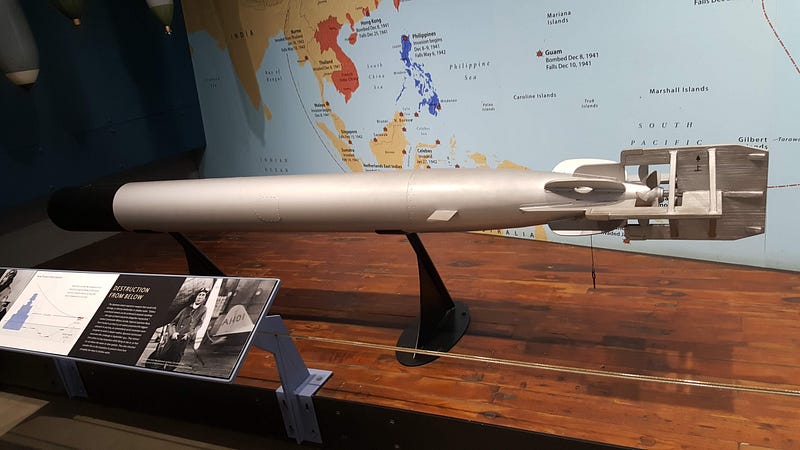 |
| Books by B J Thompson |
The Japanese aerial torpedo with attached wooden fin used at Pearl to break the dive and allow successful battleship hits in shallow water. Japanese Commander Genda, pictured here, was one of the masterminds behind its use, the idea taken from British torpedo construction used to attack the Axis enemy at Taranto, Italy, the year before. These rather small and sleek weapons were 100% responsible for the Oklahoma’s 429 dead. Somehow, I thought they’d be bigger, scarier looking. Often in life, the banal, or even the beautiful, can be deadly.
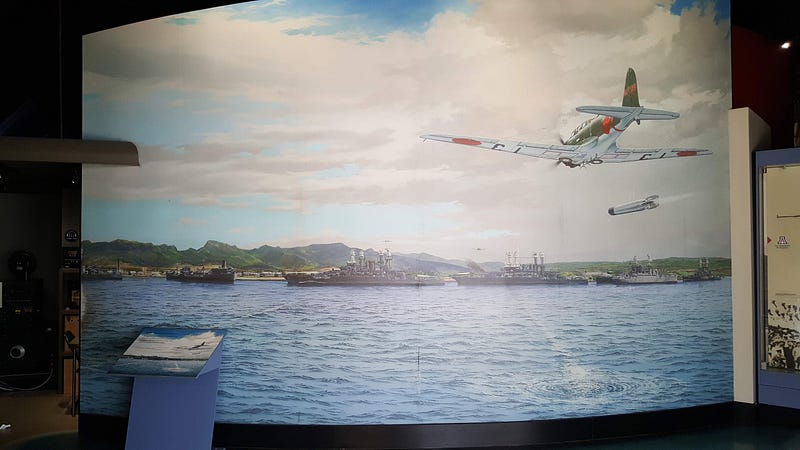 |
| Books by B J Thompson |
Also seen here, a painting depicting how the torpedo planes came in to directly hit the Okie at least nine times, the mighty battleship which had proudly sailed the open seas since 1914 (my father’s birth year), capsizing in under 8 minutes.
 |
| Books by B J Thompson |
A sailor’s white dress “cracker jack” uniform after the attack. These stains are real blood. To look at that uniform is to feel revulsion. Your stomach churns. 77 years later, death looked me directly in the face and I wanted to vomit.
The remnants of a Japanese bomb similar to the one that hit the Arizona’s powder magazine that had that dreadnought jump feet into the air, break its keel, ripping the bow to shreds, killing 1, 177 men in one fell swoop. A mock-up of the sunken Arizona as she sits today in the harbor, the stern in relative good shape, the bow, broken, sunk low into the mud — a watery coffin for all those men to this very day.
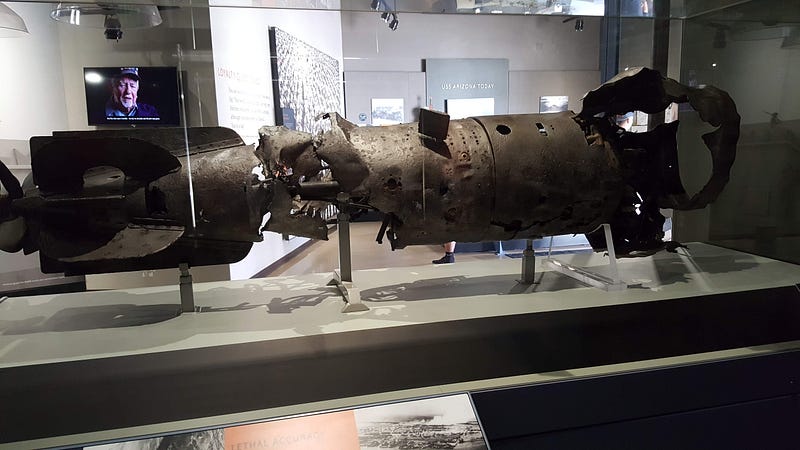 |
| Books by B J Thompson |
 |
| Books by B J Thompson |
These last shots are of President Roosevelt’s original draft copy of the Infamy speech given to Congress, December 8, 1941. Literary greatness is always birthed rough, the lines, the harried sentences, the cross-outs — an enraged man, a focused man… a tired man… determined to inject the peace-loving world, the Allies, the former isolationist American, with moral courage that would ultimately decimate dictatorships and make way for 77 years of peace. As a writer, to look at this meek paper draft was soul solidifying. That to each man and his need to change the world can, and will always, begin with the written word. If I awake on a day filled with doubt, to look at this messy draft is all the courage I need.
Episode Twenty…
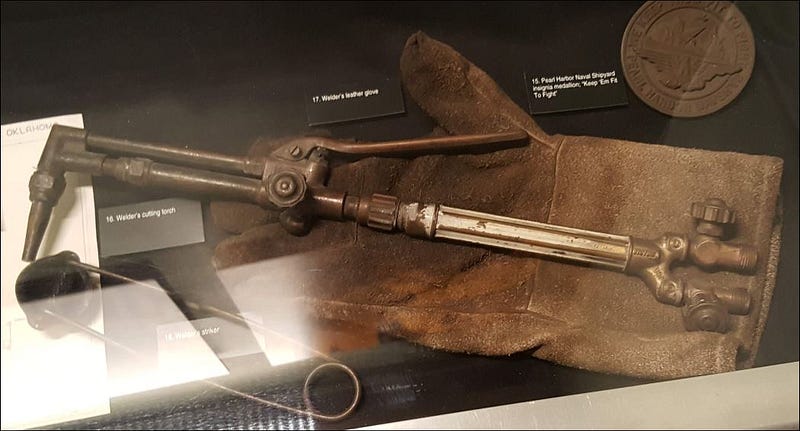 |
| Books by B J Thompson |
This final photo from the Pearl Harbor museum is of an acetylene welder’s torch and glove. When rescue efforts began on the capsized USS Oklahoma, this was the first tool the welders picked to cut into the battleship’s hull, but as fate would have it, the flame mixed with the cork insulation and created deadly fumes which killed two sailors the welders were trying to rescue. Thereafter, the rescuers stayed with the pneumatic drill — no fumes but far more time consuming work — literally banging the hull to break open a square wide enough to allow for a welder to enter the hull to drill through to the trapped sailors, and for those sailors to escape. Hours upon hours, days upon days, Julio de Castro’s civilian welder crew as well as Navy personnel worked tirelessly, and in the end managed to save 32 lives. To look at this photo is to remember the sorrow, the extreme conditions and the incredible stress suffered by those who were determined to save souls.
 |
| Books by B J Thompson |
The following day, I joined with an American couple I had met by chance down at the Mai Tai bar on Waikiki, and the three of us took a tour of Chinatown, the hub of activity for sailors on leave from Pearl in the 1940s. At the start of North Hotel Street, stands a male and female set of stone lions/foo dogs/“shishi” that guard over Chinatown. The Chinese Taoist tradition of his yang to her yin has the female, left, with a protective paw over her cub that signifies her guardianship of the people. Hers is the power of life. The male with his paw on an embroidered ball signifies good fortune and guardianship over the structures within.
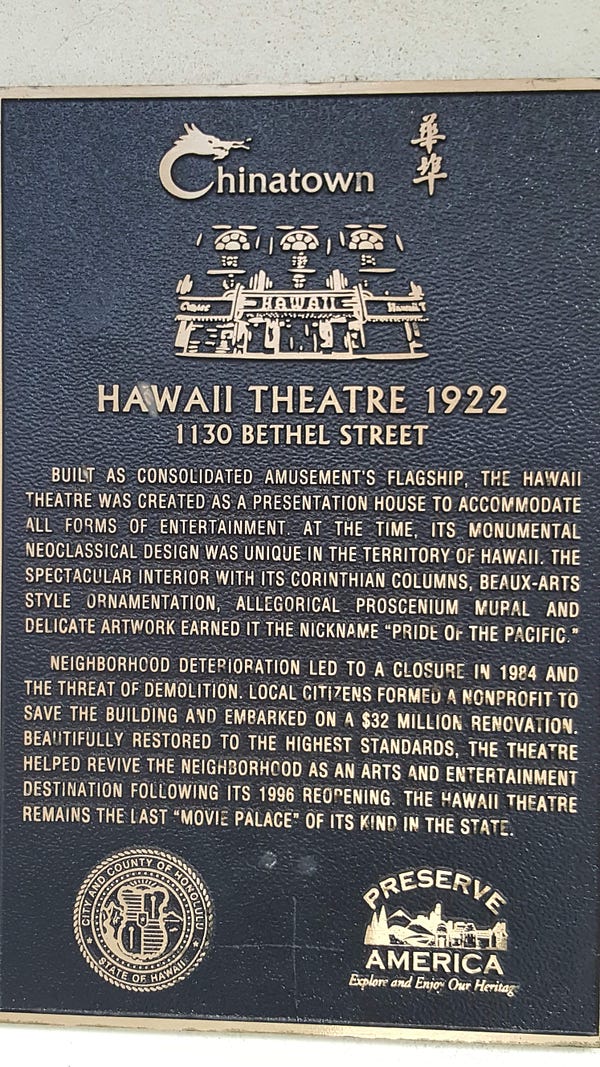 |
| Books by B J Thompson |
First stop: The Hawaii Theatre. Built in 1922, it’s a living theatre today, and not much has changed.
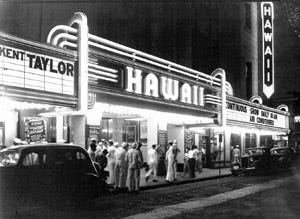 |
| Courtesy Hookele |
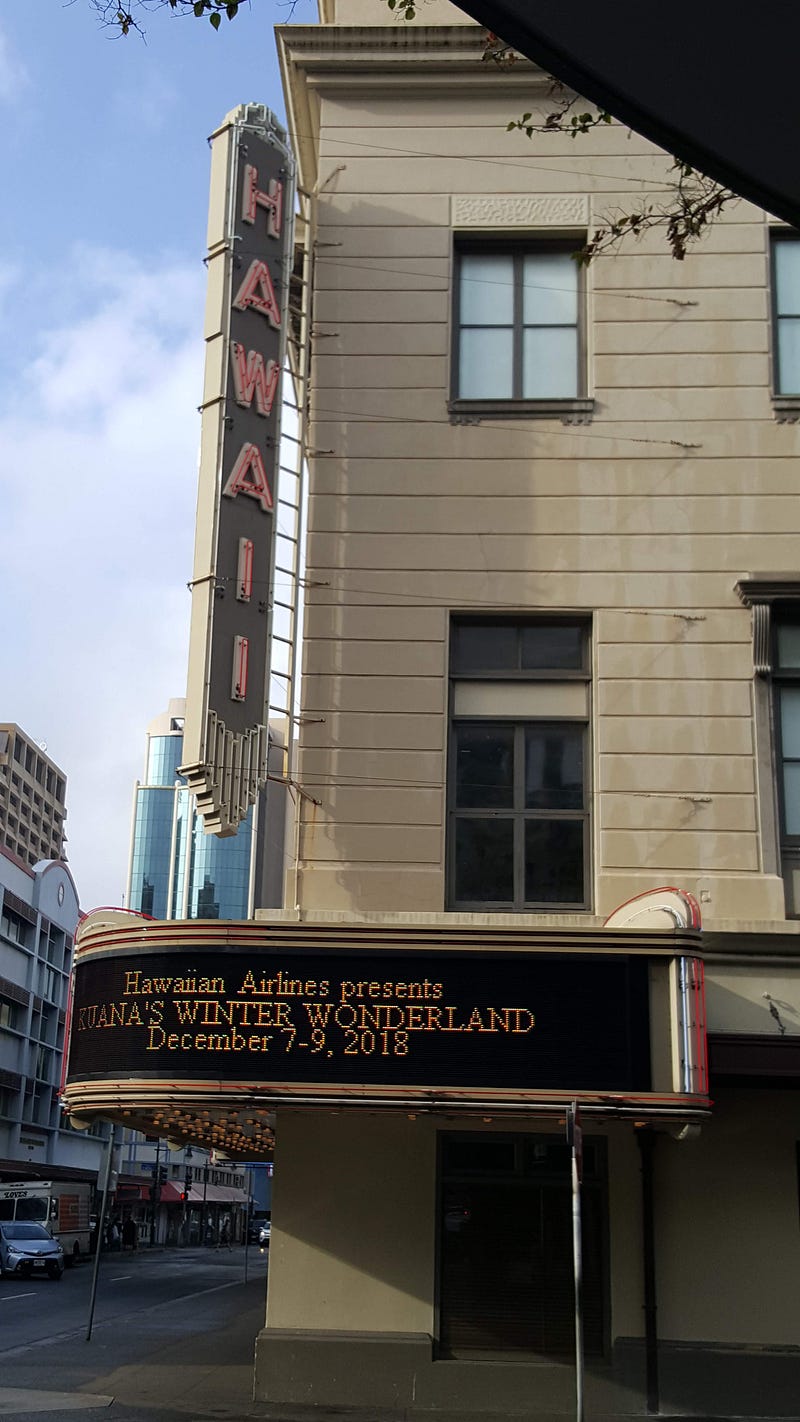 |
| Books by B J Thompson |
It was closed when we arrived but I managed a few shots of the well preserved building and the antiquated foyer doors.
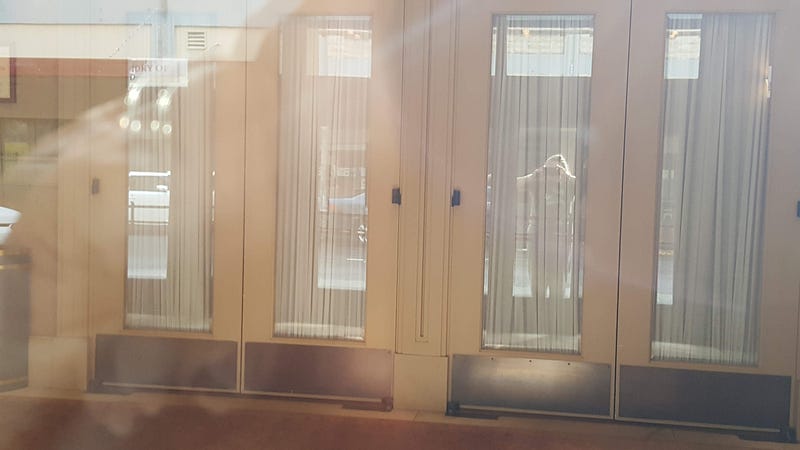 |
| Books by B J Thompson |
The handles outside looked to be of solid brass, and when I touched one, I felt transported, as if my touch followed hundreds of sailor hands who had done the same thing 77 years ago.
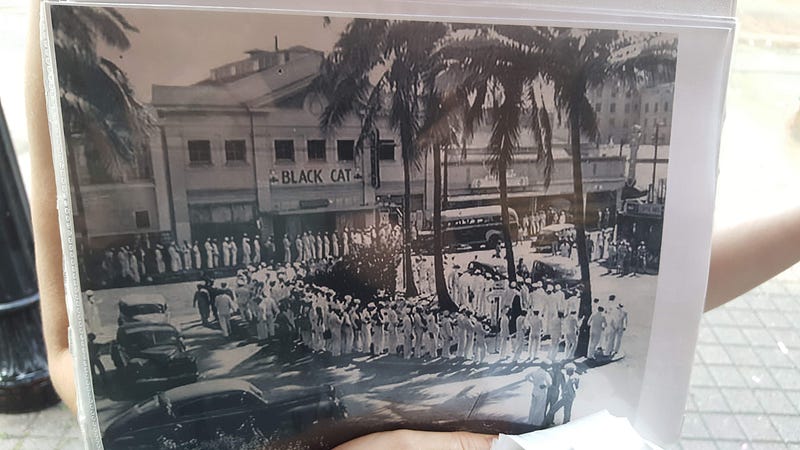
The Brothel business in Honolulu’s Chinatown — (This photo shows the Black Cat Saloon across from the Navy YMCA sailor leave drop-off point. The New Senator Hotel — among other brothels near and along Hotel and River Streets — was depicted in the movie version of James Jones best selling novel, From Here to Eternity) — was a going concern during the Pearl Harbor Navy years. Sailors on “Cinderella Leave” — you had to be back to your ship by midnight — would form lines around blocks to wait for their 3 minutes of carnal paradise for $3.00 a pop.
 |
| Books by B J Thompson |
As you can see by this map, there were as many movie theatres then as there were brothels, only to be matched by saloons and strip joints which tells you the mindset of the warrior class men. The Navy agreed to the brothels and regulated them for health and safety. Even the Big Brass acknowledged the need.
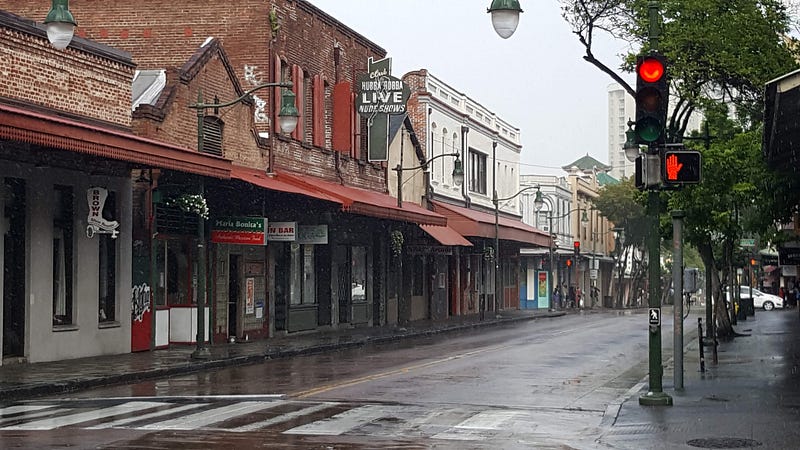 |
| Books by B J Thompson |
Second stop: Smith’s Union Bar — one of the few who have been a functioning watering hole since the 1940s, and with one look, and verification from the owner, nothing has changed inside or out.
 |
| Books by B J Thompson |
(Sad news: the week before I arrived, some jerk, who hasn’t got a clue about historical significance or may I say no grey cell intelligence, smashed the original crystal glass sign, so this bleak plywood sign hung in its place. Good news: the owner is going to have the original rebuilt).
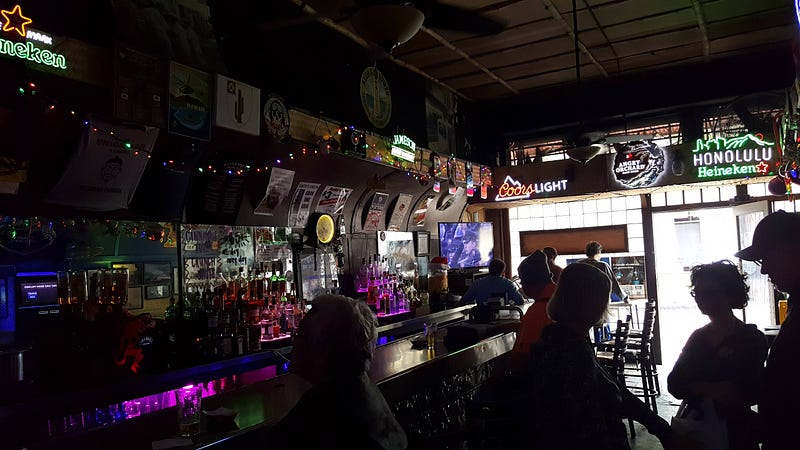 |
| Books by B J Thompson |
It was rather ironic that on the very day I visited, the Army/Navy football game was being televised. As of leaving the bar, Navy was losing. Boo! Yes, it’s a dive, but would you expect anything else from rough and tumble sailors back then? They wanted cheap Primo or Hula beer, a lively juke box, and a patient and pleasant bartender. (You can buy the late USS Arizona survivor Lauren Bruner’s book at the bar.)
 |
| Books by B J Thompson |
Oh, and a latrine, which happens to not have been improved since the 1940s. This is the original urinal! Posh, indeed.
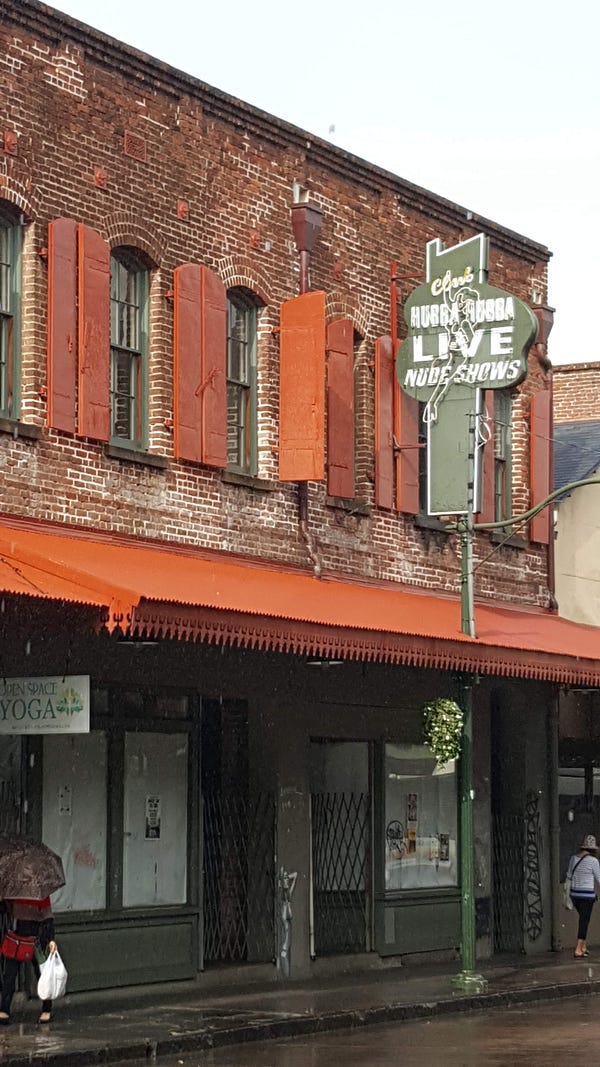 |
| Books by B J Thompson |
Third stop: The HUBBA BUBBA strip club right next door. This was considered the most popular strip club in 1941 as it had the longest catwalk of all the Honolulu clubs. By 2018, it had already been closed for several years but before its closing, it had been up and running since 1941.
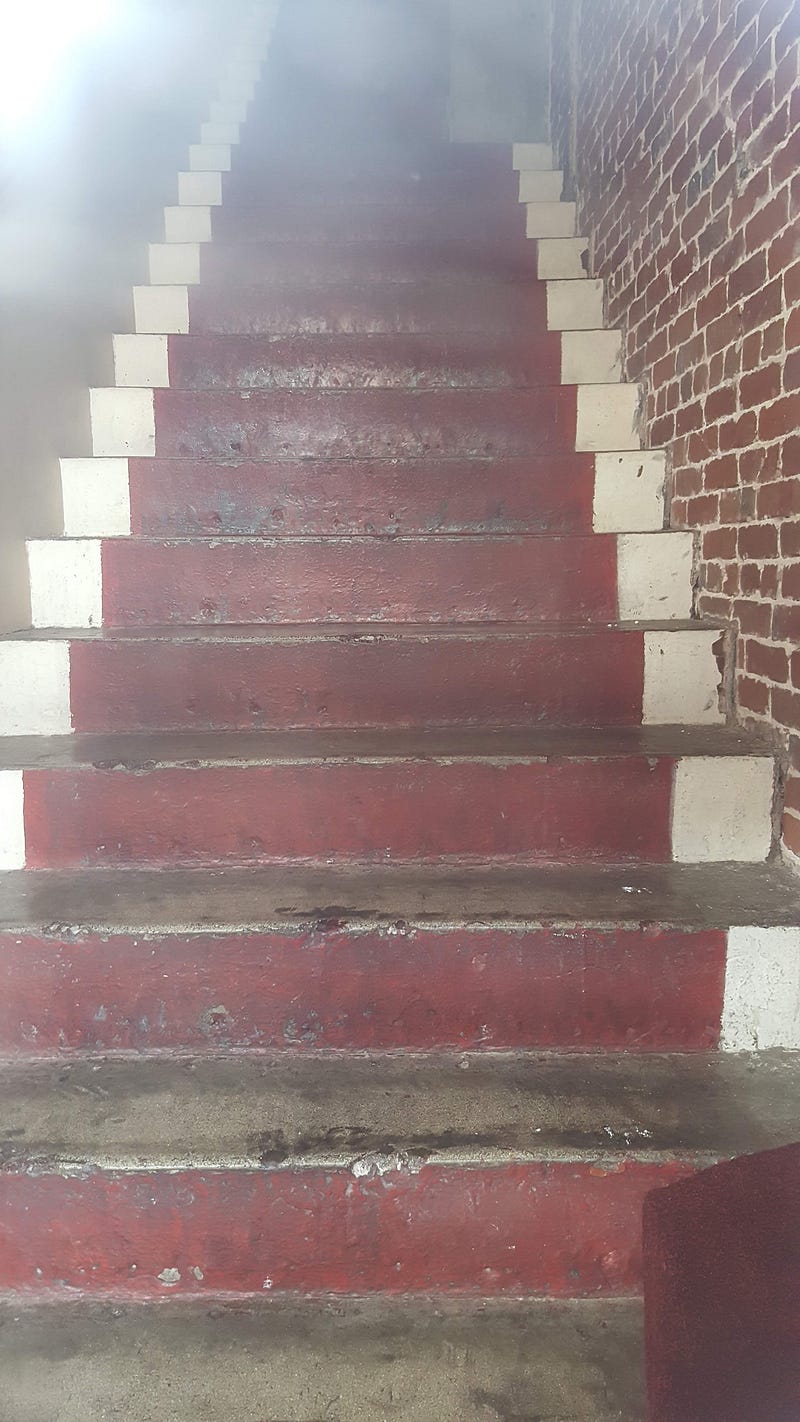 |
| Books by B J Thompson |
Above the strip club was a brothel — good planning! And here are the original stairs up to that carnal oasis. The tour guide told us they are as they were back then, so in my mind’s eye, I saw cracker-jack and after cracker-jack climbing those stairs. It made me smile.
 |
| Books by B J Thompson |
Fourth stop: The Swing Club, now considered an historical spot with accompanying plaque (and yes, Sarah Vaughan’s name is spelled incorrectly) was another hot nightspot for sailors wanting drinks and entertainment. As you can see by the tour guide’s photo…
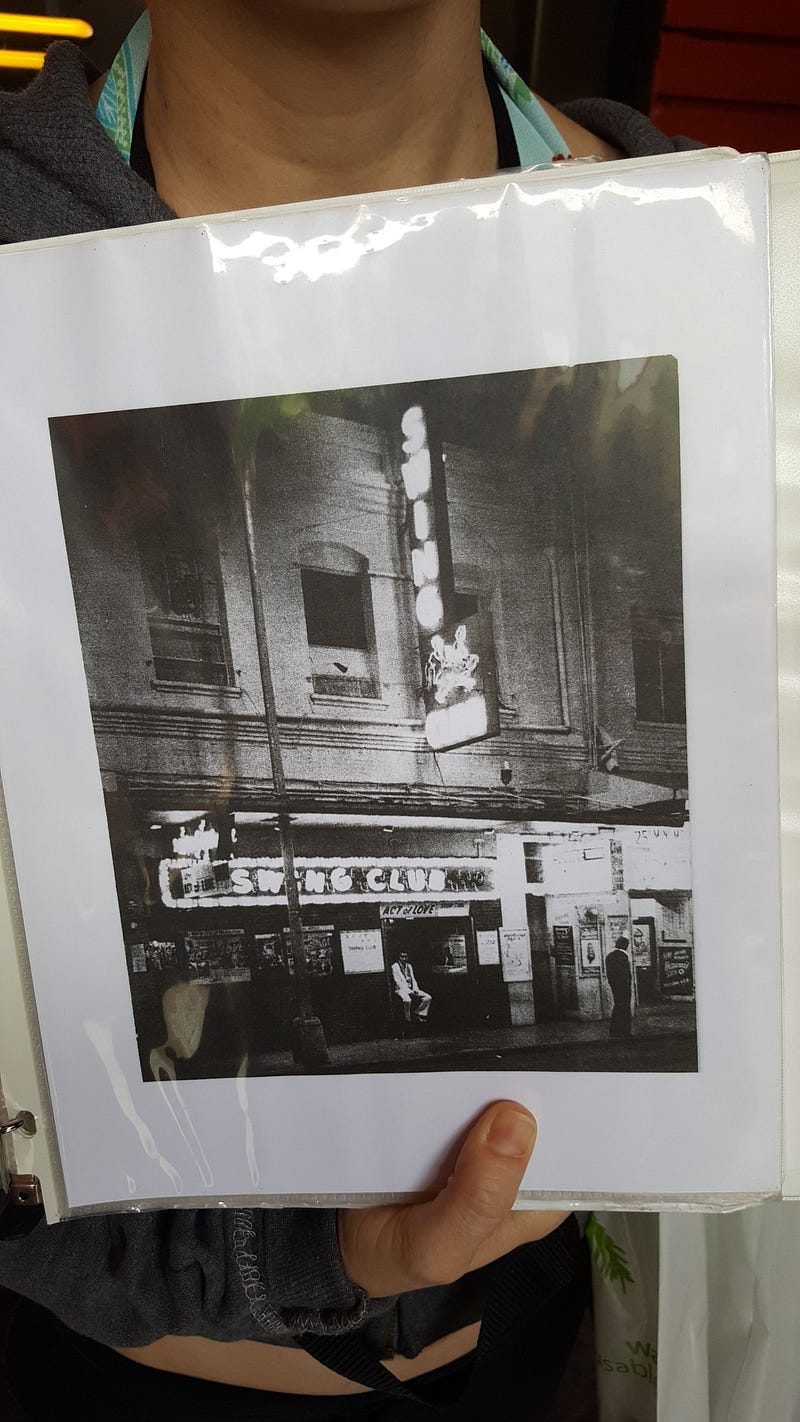 |
| Books by B J Thompson |
and today’s look it is difficult to connect the past with the present only to say that the…
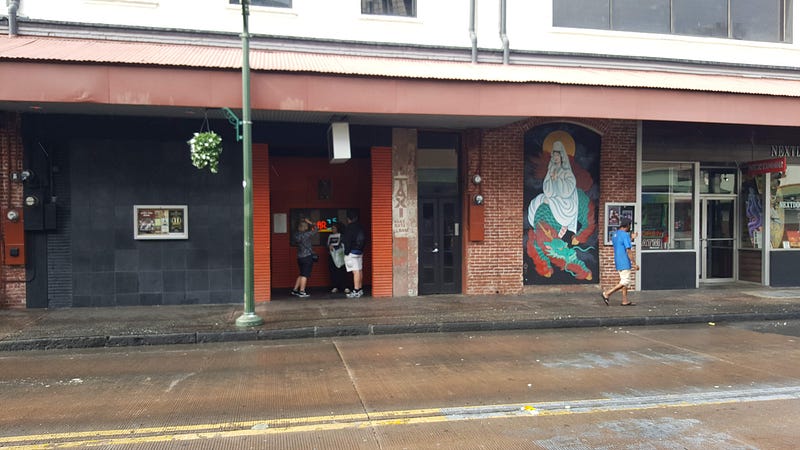 |
| Books by B J Thompson |
TAXI sign outside is the original one that stood outside in the 40s, and no doubt sailors who went to their deaths the morning of December 7th, 1941caught their very last taxi here, at this stand, just before midnight.
 |
| Books by B J Thompson |
I felt the finality of this spot. I felt the gaiety, too, but there was a dark cloud hovering here. The feeling hit too close to home for me and my boys in AIR. I took the photo and walked away. Too many dead men hovering in my subconscious for me to linger.
My journey continues…


